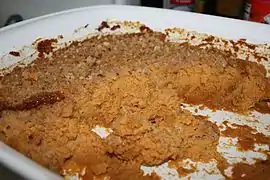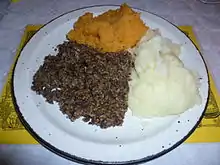Rutabaga
Swede (British and Commonwealth English), Rutabaga (/ˌruː.təˈbeɪ.ɡə/) (American English), Neep (Scottish), and turnip (Canadian English, Northern English, Irish English, and Cornish English) is a root vegetable, a form of Brassica napus (which also includes rapeseed). Other names include Swedish turnip, or "Yellow turnip". The species Brassica napus originated as a hybrid between the cabbage (Brassica oleracea) and the turnip (Brassica rapa). Rutabaga roots are eaten as human food in a variety of ways, and the leaves can be eaten as a leaf vegetable. The roots and tops are also used for livestock, either fed directly in the winter or foraged in the field during the other seasons. Scotland, Northern England, West England and Ireland had a tradition of carving the roots into lanterns at Halloween.
| Rutabaga | |
|---|---|
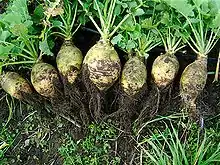 Rutabaga | |
| Species | Brassica napus |
| Cultivar group | Napobrassica Group |
Etymology

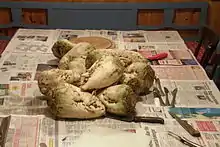
Rutabaga has many national and regional names. Rutabaga is the common North American term for the plant. This comes from the Swedish dialectal word rotabagge,[1] from rot (root) + bagge (lump, bunch).[2] In the U.S., the plant is also known as Swedish turnip or yellow turnip.[3][4]
The term swede (from "Swedish turnip") is used in many Commonwealth Nations, including much of England, Australia, and New Zealand. The name turnip is also used in parts of Northern and Midland England, the West Country (particularly Cornwall), Ireland, the Isle of Man, Manitoba, Ontario, Quebec and Atlantic Canada. In Wales, according to region, it is variously known as maip, rwden, erfin, swedsen, or swejen in Welsh,[5] and as swede or turnip in English.
In Scotland it is known as turnip, tumshie (also used as a pejorative term for foolish or stupid people) or neep (from Old English næp, Latin napus).[6] Some areas of south-east Scotland, such as Berwickshire and Roxburghshire, still use the term baigie, possibly a derivative of the Swedish dialectal word rotabagge.[7] The term turnip is also used for the white turnip (Brassica rapa ssp rapa).[6][8]
Some will also refer to both swede and (white) turnip as just turnip (this word is also derived from næp).[8] In north-east England, turnips and swedes are colloquially called snadgers, snaggers (archaic) or narkies.[9] Rutabaga is also known as moot in the Isle of Man and the Manx language word for turnip is napin.[10]
Its common name in Sweden is kålrot (literally "cabbage/kale root"). Similarly, in Denmark it is known as kålroe and kålrabi, while in Norway it is known as kålrabi or kålrot and in Estonia as kaalikas. In Dutch it is called similarly koolraap. In Denmark, Norway and the Netherlands, it is sometimes confused with kohlrabi. The Finnish term is lanttu. The Romanian term is nap. Rutabaga is known by many different regional names in German, of which Kohlrübe and Steckrübe are the most widespread and most commonly used in lists of ingredients; the former is typically used in Austria to mean kohlrabi.
History
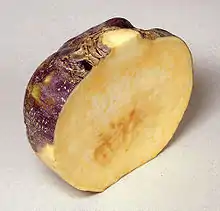
The first known printed reference to the rutabaga comes from the Swiss botanist Gaspard Bauhin in 1620, where he notes that it was growing wild in Sweden. It is often considered to have originated in Scandinavia, Finland or Russia.[11] According to the Natural Resources Institute of Finland (Luke), rutabaga or lanttu was most likely bred on more than one occasion in Northern Europe, around the 16th century. Studies by former MTT (now Luke), has shown lanttu was developed independently in both Finland and Sweden, from turnip and cabbage in connection with seed cultivation.[12] There are contradictory accounts of how rutabaga arrived in England. Some sources say it arrived in England by way of Germany, while other accounts support Swedish origins. According to John Sinclair the root vegetable arrived in England from Germany around 1750.[13] Rutabaga arrived in Scotland by way of Sweden around 1781.[14]
An article on the topic in The Gardeners' Chronicle suggests that the rutabaga was then introduced more widely to England in 1790. Introduction to North America came in the early 19th century with reports of rutabaga crops in Illinois as early as 1817.[15] In 1835 a Rutabaga fodder crop was recommended to New York farmers in the Genesee River valley.[16]
Rutabaga was once considered a food of last resort in both Germany and France due to its association with food shortages in World War I and World War II. Boiled stew with rutabaga and water as the only ingredients (Steckrübeneintopf) was a typical food in Germany during the famines and food shortages of World War I caused by the Allied blockade (the Steckrübenwinter or Turnip Winter of 1916/17) and between 1945 and 1949. As a result, many older Germans had unhappy memories of this food.[17]
World War II
One diary, written by an anonymous young girl from the Łódź Ghetto, contained substantial discussion about food and hunger. Łódź was the only ghetto on "German" soil and, due to this peculiarity of its character, the black market smuggling of food and other necessities had not been possible. Out of the "major ghettos", Łódź had been the most affected by hunger, starvation, and malnutrition-related deaths. The young diarist recounts in detail her father arriving home one evening with two stolen rutabagas. Each of the rutabagas was divided into 3 portions which she noted "worked out at seventy decagrams [700 g; 25 oz] each". Though her father had been given some small pieces of rutabaga, she wrote that "He knew there was nothing to eat at home, so he didn't eat them on the spot although he was very hungry … I can't write anymore because my eyes are filled with tears."[18]
Walter Meyer, who was a prisoner at the Ravensbrück men's camp, has written that "rutabaga soup became the staple food".[19] One American POW recalled rutabaga soup "made from peelings".[20] A prisoner who was held at a POW camp for captured Polish officers said the Germans provided prisoners with only small portions of soup made from "just water and rutabaga".[21] Another survivor who was held at Westerbork and the Bergen-Belsen concentration camp noted the poor quality of the rutabagas themselves, saying that in some cases prisoners would even discard the "dried out and gray" rutabagas.[22]
A circular from April 1942 discusses cuts to the rations of the German population by the Reich Ministry of Food and Agriculture. The text gives an account of Germany's dwindling food supply, concluding: "To fill the gap, the Hitler government, just like 25 years ago, the government of Wilhelm II, will feed the German people with promises and with rutabagas" using the German word Kohlrüben for rutabaga.[23]
Botanical history
Rutabaga has a complex taxonomic history. The earliest account comes from the Swiss botanist Gaspard Bauhin, who wrote about it in his 1620 Prodromus.[15] Brassica napobrassica was first validly published by Carl Linnaeus in his 1753 work Species Plantarum as a variety of B. oleracea: B. oleracea var. napobrassica.[24] It has since been moved to other taxa as a variety, subspecies, or elevated to species rank. In 1768, a Scottish botanist elevated Linnaeus' variety to species rank as Brassica napobrassica in The Gardeners Dictionary, which is the currently accepted name.[25]
Rutabaga has a chromosome number of 2n = 38. It originated from a cross between turnip (Brassica rapa) and Brassica oleracea. The resulting cross then doubled its chromosomes, becoming an allopolyploid. This relationship was first published by Woo Jang-choon in 1935 and is known as the Triangle of U.[26]
Cuisine
Finland
Finns eat and cook rutabaga in a variety of ways. Rutabaga is the major ingredient in the popular Christmas dish lanttulaatikko (rutabaga casserole), one of the three main casseroles served during the Finnish Christmas, along side with the potato, and the carrot casseroles.
Uncooked and thinly julienned rutabaga is often served as a side dish salad in school and work place lunches. Raisins or canned pineapple in light syrup are often added to the rutabaga salad. Sometimes, thinly sliced raw carrots are mixed in with rutabaga.
Finns use rutabaga in most dishes that call for a root vegetable. Most of the Finnish soup bases consist of potatoes, carrots and rutabagas. The stock is often flavoured with peppercorns and bay leaves, and sometimes milk or herbs, such as dill, are added. Salmon or beef is added to this soup base and ever more increasingly the meat is replaced with vegan meat alternative, such as Nyhtökaura pulled oats or broad bean protein chunks.
Finnish cuisine also roasts, bakes, boils and grills rutabagas. Oven baked root vegetables is yet another home cooking classic in Finland: rutabaga, carrots, beetroots and potatoes are roasted in the oven with salt and oil. Karjalanpaisti (Carelian hot pot) is a popular slow cooking stew with root vegetables and meat cooked over a long time in a dutch oven.
The Finnish supermarkets sell alternative potato chips, made out of root vegetables, such as rutabagas, beetroots and carrots.
Scandinavia

In Sweden and Norway, rutabaga is cooked with potato and sometimes carrot, and mashed with butter and either stock or, occasionally, milk or cream, to create a puree called rotmos (Swedish, literally: root mash) or kålrabistappe (Norwegian). Onion is occasionally added. In Norway, kålrabistappe is an obligatory accompaniment to many festive dishes, including smalahove, pinnekjøtt, raspeball and salted herring. In Sweden, rotmos is often eaten together with cured and boiled ham hock, accompanied by mustard. This classic Swedish dish is called fläsklägg med rotmos. In Wales, a similar mash produced using just potato and rutabaga is known as ponsh maip in the North-East of the country,[27] as mwtrin on the Llyn peninsula and as stwnsh rwden in other parts.[28]
Europe
In the Netherlands, rutabaga is traditionally served boiled and mashed. Adding mashed potatoes (and, in some recipes, similarly mashed vegetables or fruits) makes stamppot (English: mash pot), a dish often served alongside smoked sausage.
In Scotland, separately boiled and mashed, rutabagas (neeps) and potatoes are served as "neeps and tatties" ("tatties" being the Scots word for potatoes), in a traditional Burns supper, together with the main course of haggis (the Scottish national dish). Neeps mashed with carrots or potatoes is called clapshot. In Orkney neeps mashed with potatoes (tatties) is called clapshot. Roughly equal quantities of neeps and tatties are boiled together in salted water and mashed with much butter. Seasoning can be augmented with black pepper. Onions are never used. Regionally, neeps are a common ingredient in soups and stews.
In England, swede is boiled together with carrots and served either mashed or pureed with butter and ground pepper. The flavored cooking water is often retained for soup, or as an addition to gravy. Swede is an essential vegetable component of the traditional Welsh lamb broth called cawl and Irish stew as eaten in England. Swede is also a component of the popular condiment Branston Pickle. The swede is also one of the four traditional ingredients of the pasty originating in Cornwall.
Rest of the World
In Canada they are considered winter vegetables, as along with similar vegetables they are able to be kept in a cold area or cellar for several months. They are primarily used as a side dish. They are also used as filler in foods such as mincemeat and Christmas cake.
In the US, rutabagas are not widely eaten, but may be found as part of stews or casseroles, served mashed with carrots, or baked in a pasty. They are frequently found in the New England boiled dinner.
In Australia, swedes are used as a flavor enhancer in casseroles, stews and soups.
Phytochemistry
| Nutritional value per 100 g (3.5 oz) | |
|---|---|
| Energy | 157 kJ (38 kcal) |
8.62 g | |
| Sugars | 4.46 g |
| Dietary fiber | 2.3 g |
0.16 g | |
1.08 g | |
| Vitamins | Quantity %DV† |
| Thiamine (B1) | 8% 0.09 mg |
| Riboflavin (B2) | 3% 0.04 mg |
| Niacin (B3) | 5% 0.7 mg |
| Pantothenic acid (B5) | 3% 0.16 mg |
| Vitamin B6 | 8% 0.1 mg |
| Folate (B9) | 5% 21 μg |
| Vitamin C | 30% 25 mg |
| Minerals | Quantity %DV† |
| Calcium | 4% 43 mg |
| Iron | 3% 0.44 mg |
| Magnesium | 6% 20 mg |
| Manganese | 6% 0.131 mg |
| Phosphorus | 8% 53 mg |
| Potassium | 6% 305 mg |
| Zinc | 3% 0.24 mg |
| |
| †Percentages are roughly approximated using US recommendations for adults. Source: USDA FoodData Central | |
Rutabaga and other cyanoglucoside-containing foods (including cassava, maize (corn), bamboo shoots, sweet potatoes, and lima beans) release cyanide, which is subsequently detoxified into thiocyanate. Thiocyanate inhibits thyroid iodide transport and, at high doses, competes with iodide in the organification process within thyroid tissue. Goitres may develop when there is a dietary imbalance of thiocyanate-containing food in excess of iodine consumption, and it is possible for these compounds to contribute to hypothyroidism.[29][30][31][32] Yet, there have been no reports of ill effects in humans from the consumption of glucosinolates from normal amounts of Brassica vegetables. Glucosinolate content in Brassica vegetables is around one percent of dry matter. These compounds also cause the bitter taste of rutabaga.[33]
As with watercress, mustard greens, turnip, broccoli and horseradish, human perception of bitterness in rutabaga is governed by a gene affecting the TAS2R bitter receptor, which detects the glucosinolates in rutabaga. Sensitive individuals with the genotype PAV/PAV (supertasters) find rutabaga twice as bitter as insensitive subjects (AVI/AVI). For the mixed type (PAV/AVI), the difference is not significant for rutabaga.[34] As a result, sensitive individuals may find some rutabagas too bitter to eat.
Other chemical compounds that contribute to flavor and odor include glucocheirolin, glucobrassicanapin, glucoberteroin, gluconapoleiferin, and glucoerysolin.[35] Several phytoalexins that aid in defense against plant pathogens have also been isolated from rutabaga, including three novel phytoalexins that were reported in 2004.[36]
Rutabaga contains significant amounts of vitamin C: 100 g contains 25 mg, which is 30% of the daily recommended dose.[37]
Other uses
Livestock
The roots and tops of "swedes" came into use as a forage crop in the early nineteenth century, used as winter feed for livestock. They may be fed directly (chopped or from a hopper), or animals may be allowed to forage the plants directly in the field.[38]
Halloween

People living in Northern England, West England, Ireland and Scotland have long carved turnips and often used them as lanterns to ward off harmful spirits.[39] In the Middle Ages, rowdy bands of children roamed the streets in masks carrying carved turnips known in Scotland as "tumshie heads".[40][41] In modern times, turnips are often carved to look as sinister and threatening as possible, and are put in the window or on the doorstep of a house at Halloween to ward off evil spirits.[42][43]
Since pumpkins became readily available in Europe in the 1980s, they have taken over this role to a large extent.[44] In the Isle of Man, turnip lanterns are still carved at Hop-tu-Naa (Manx equivalent of Halloween), lit with a candle or electric torch, and carried from house to house by some children, with the accompanying Hop tu Naa song; hoping for money or treats of food.[10][45][46] The smell of burning turnip is an evocative part of the event.
Festivals
A local farmers' market in the town of Ithaca, New York organizes what it calls the "International Rutabaga Curling Championship" annually on the last day of the market season.[47] The villages of Askov, Minnesota, and Cumberland, Wisconsin, both hold an annual "rutabaga festival" in August.[48][49]
See also
References
- "rutabaga, n." OED Online. Oxford University Press, September 2015. Retrieved 7 December 2015.
- Våra ord: rotabagge(Swedish) Linked 2018-03-02
- McLaughlin, Chris. The Complete Idiot's Guide to Heirloom Vegetables. Penguin, 2010. ISBN 9781101441831. p. 208.
- Lindsay, Anne. Anne Lindsay's Smart Cooking. John Wiley & Sons, 2008. ISBN 9780470157114. p. 174
- "Geiriadur yr Academi | The Welsh Academy English-Welsh Dictionary Online". geiriaduracademi.org (in Welsh). Retrieved 16 March 2018.
- The Concise Scots Dictionary, Mairi Robinson (editor) (1985)
- Dictionary of the Scots Language: baigie" Relinked 2018-03-02.
- Chambers English Dictionary (Chambers 1988), ISBN 1-85296-000-0
- Rana, M. K. Vegetable Crop Science. CRC Press, 2017. Chapter 47. ISBN 9781351648875.
- "Photo". wiki1.sch.im.
- Hawkes, Alex D. 1968. A World of Vegetable Cookery. New York: Simon and Schuster.
- Geenit valottavat vanhaa viljelykulttuuria.
- Harvey, Nigel (1949). "The Coming of the Swede to Great Britain: An Obscure Chapter in Farming History". Agricultural History. 23 (4): 286–288. ISSN 0002-1482. JSTOR 3740589.
- "Swede". Oxford English Dictionary (Online ed.). Oxford University Press. (Subscription or participating institution membership required.)
- Sturtevant, E. L. 1919. Sturtevant's Notes on Edible Plants. Albany, NY: J. B. Lyon Company, p. 105.
- James Houghton (1835) The Culture of Ruta Baga, Genesee Farmer via HathiTrust
- Back to our Roots, Talking Food magazine
- Zapruder, Alexandra, ed. (2015). Salvaged Pages: Young Writers' Diaries of the Holocaust. Yale University Press. pp. 226–242. ISBN 978-0-300-20599-2.
- Meyer, Walter; Valentine, Matt (1999). Tomorrow Will Be Better: Surviving Nazi Germany. University of Missouri Press. p. xiii. ISBN 978-0-8262-6114-4.
- Rolen, John William (1988). American Ex-prisoners of War: Non Solum Armis. Turner Publishing Company. ISBN 978-1-56311-173-0.
- "Oral history interview with Jerzy Lubelfeld". United States Holocaust Memorial Museum. p. 25. Retrieved 10 August 2018.
- "Ruth Moser Borsos". United States Holocaust Memorial Museum. p. 9. Retrieved 10 August 2018.
- "Handbill with commentary on wartime food ration reductions in Germany - Collections Search - United States Holocaust Memorial Museum". Retrieved 10 August 2018.
- "Brassica napus rapifera". International Plant Names Index (IPNI). Royal Botanic Gardens, Kew. Retrieved 30 October 2009.
- International Plant Names Index (IPNI). Royal Botanic Gardens, Kew https://www.ipni.org/n/72249-3. Retrieved 30 October 2009. Missing or empty
|title=(help) - Dixon, G.R. 2007. Vegetable Brassicas and Related Crucifers. CABI: Oxfordshire, UK. pp. 6–36.
- "BBC - Geirfa'r gogledd ddwyrain". www.bbc.co.uk (in Welsh). Retrieved 16 March 2018.
- "Amser Bwyd". Amgueddfa Cymru (in Welsh). Retrieved 16 March 2018.
- Olsson, K.; Jeppsson, L. (1984). "Undesirable glucosinolates in Brassica vegetables". Acta Hort. 163 (163): 83–84. doi:10.17660/ActaHortic.1984.163.9.
- Jones, D.A. (1998). "Why are so many food plants cyanogenic?". Phytochemistry. 47 (2): 155–162. doi:10.1016/s0031-9422(97)00425-1. PMID 9431670.
- Delange F, Iteke FB, Ermans AM. Nutritional factors involved in the goitrogenic action of cassava. Ottawa: International Development Research Centre, 1982.
- Braverman LE, Utiger RD. Werner and Ingbar's The Thyroid: A Fundamental and Clinical Text, 6th Edition 1991. J.B. Lippincott Company, Philadelphia, Pennsylvania, pp. 371–2.
- Verkerk, R.; Schreiner, M.; Krumbein, A.; Ciska, E.; Holst, B.; Rowland, I.; De Schrijver, R.; Hansen, M.; Gerhäuser, C.; Mithen, R.; Dekker, M. (2009). "Glucosinolates in Brassica vegetables: The influence of the food supply chain on intake, bioavailability and human health". Mol. Nutr. Food Res. 53: S219–S265. doi:10.1002/mnfr.200800065. PMID 19035553.
- Sandell, Mari A.; Breslin, Paul A.S. (2006). "Variability in a taste-receptor gene determines whether we taste toxins in food". Current Biology. 16 (18): R792-4. doi:10.1016/j.cub.2006.08.049. PMID 16979544. S2CID 17133799.
- Harborne, J. B., Baxter, H., and Moss, J. P. 1999. Phytochemical Dictionary: A Handbook of Bioactive Compounds from Plants. Philadelphia, PA: Taylor and Francis, Inc.
- Pedras, M. S. C.; Montaut, S.; Suchy, M. (2004). "Phytoalexins from the crucifer rutabaga: structures, syntheses, biosyntheses, and antifungal activity". J. Org. Chem. 69 (13): 4471–4476. doi:10.1021/jo049648a. PMID 15202903.
- "Rutabagas". Healthaliciousness.com. Retrieved 15 September 2012.
- SRUC. "Swedes and Turnips - SRUC". sruc.ac.uk.
- Arnold, Bettina (31 October 2001). "Bettina Arnold – Halloween Lecture: Halloween Customs in the Celtic World". Halloween Inaugural Celebration. University of Wisconsin–Milwaukee: Center for Celtic Studies. Retrieved 16 October 2007.
- Rogers, Nicholas (2002). "Festive Rights: Halloween in the British Isles". Halloween: From Pagan Ritual to Party Night. pp. 43, 48. Oxford University Press.
- Bannatyne, Lesley Pratt (1998). Forerunners to Halloween. Pelican Publishing Company. ISBN 1-56554-346-7 p. 44
- "Pumpkins Passions", BBC, 31 October 2005. Retrieved on 19 October 2006. "Turnip battles with pumpkin for Hallowe'en", BBC News, 28 October 2005. Retrieved 23 September 2007.
- "Get traditional with a turnip this year - Top stories - Scotsman.com". Edinburghnews.scotsman.com. 28 October 2009. Retrieved 15 September 2012.
- Baxter, I. A., Schröder, M. J. A., and Bower, J. A. (1999), "The influence of socio-economic background on perceptions of vegetables among Scottish primary school children", Food Quality and Preference, 10 (4–5): 261–272, doi:10.1016/S0950-3293(98)00042-1CS1 maint: multiple names: authors list (link)
- Telecom, Manx. "Hop Tu Naa Celebrations at Cregneash - Isle of Man News | Manx.net". www.manx.net. Retrieved 16 March 2018.
- "The Manx festival of Hop-tu-Naa". BBC News. 24 October 2011. Retrieved 16 March 2018.
- "The International Rutabaga Curl - Ithaca Farmers Market - Ithaca NY". Rutabagacurl.com. 17 December 2011. Retrieved 15 September 2012.
- "Rutabaga Festival Parade - Cumberland Chamber of Commerce, WI". www.cumberland-wisconsin.com.
- "Askov Rutabaga Festival & Fair: A Community Event -". Askov Rutabaga Festival & Fair: A Community Event.
External links
| Wikimedia Commons has media related to Brassica napus subsp. rapifera. |
| Look up rutabaga, swede, or neep in Wiktionary, the free dictionary. |
- Alternative Field Crops Manual: Rutabaga—Center for New Crops & Plant Products, Purdue University
- Smillie, Susan. "Are 'neeps' swedes or turnips?", The Guardian, 25 January 2010.
